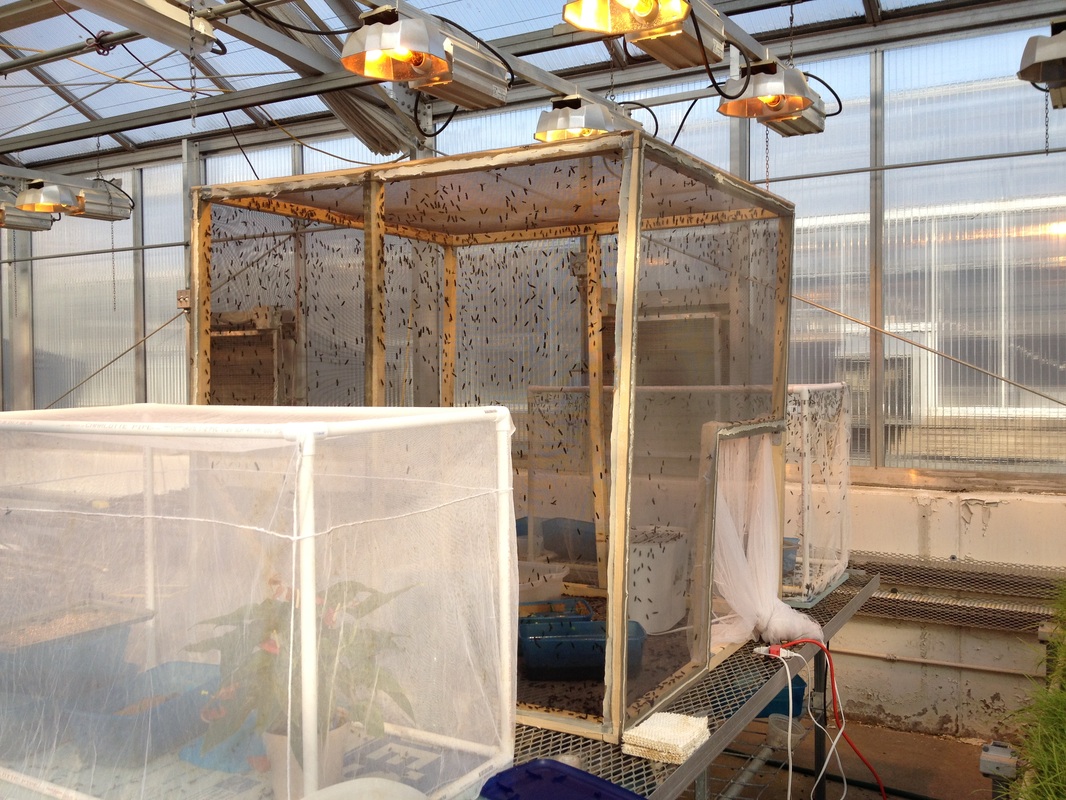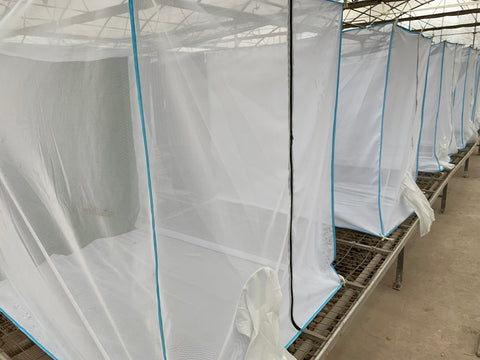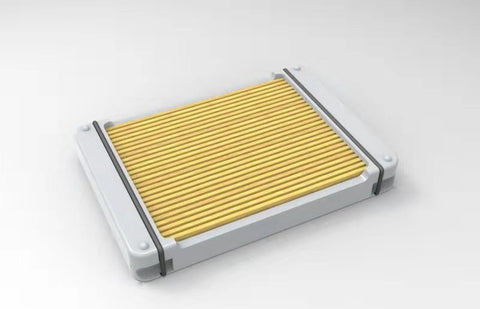Black soldier fly is native to most areas in the United States, but the density of the population might vary across states. If you don't see them frequently in your area, it means you don't have millions of them around, and you will find it hard to attract fertilized females to lay eggs in your nursery. In this situation, a fly cage is highly recommended. In the picture below, there are two types of cages. One is made from PVC pipes (48*25*20 inch) and covered with baby insect-proof net. The size of this type is limited by the size of available netting. In the middle is a wood-framed cage (48*48*48 inch), and it's covered by common screen mesh. Either one works pretty well. There is a standard product for black soldier fly breeding purposes available HERE.

Allowing the maximum amount of direct sunlight available to the setup is the key to successful mating. If you are breeding indoor, make sure your colony gets the window that is facing south to maximize the amount of direct sunlight that's accessible to the cage. However, in many northern regions where sunlight is not adequate, you need to consider installing an artificial light source for black soldier fly breeding. Black soldier fly adults have special visual receptors, and successful mating only occurs when the right lights are available. The EVO Consortium has developed a LED light source that's specific for black soldier fly breeding purposes, and they are available HERE, and a test report for this black soldier fly breeding LED is available HERE.

Besides the light condition, the temperature should be kept above 23 degrees Celsius all the time for successful mating, and above 13 degrees Celsius to keep flies alive. Humidity should be around 50%. In the cage, all you need is to provide a clean water source and an attractant for oviposition (egg-laying). To make clean water available to the flies, you can place a small fountain, but make sure to avoid deep water standing, because black soldier fly is easy to drown. For the oviposition site, a plastic box with rotting organic matter (such as bananas, cornmeal, wheat bran) is necessary. For the best result, place a couple of thousand young larvae in the organic matter. The adult black soldier flies do not eat, the food is just for them to know where to lay eggs. Directly above the rotting material, using a rubber band to hold together 4-5 pieces of cardboard, and the fertile females would lay eggs in the cardboard flutes. For industrial farms that harvest hundreds of grams of egg per day, using a specially designed egg trap, for example, the ORI_1130 product, is necessary. The food should be kept moist all the time, otherwise, the female will lay directly on the food source, which will cause inconvenience for management. Usually, if you do not use antibiotics in the food for an attractant, the material will mold up after 2 or 3 days, and you have to replace the material frequently to avoid stinks. One way we found to be effective to prevent molds is introducing one or two thousand small black soldier fly larvae in the food source because the larvae can consume the fungi that cause the mold, and they can produce chemicals that inhibit fungi and bacterias growth. In this way, you can change the food source less frequently.

Farmers should harvest the eggs (replace the cardboard) every day or every two days to make the empty flute space available for the oviposition. The eggs can be directly introduced to the working grub compost for hatching. The black soldier fly larvae will not consume your eggs unless the eggs are already dead and rotting. This is a good thing because when the larvae consume those rotting eggs, other eggs that haven't been infected will be fine till hatching.
Setting up a nursery can help you have a better idea of how many small larvae you are dealing with, and can help you to detect some other problems that you might otherwise not be aware of, such as hatching failure. Below is the video we made to explain how we set up a nursery for black soldier fly hatching. Most importantly, this set up can allow you to leave it unattended for ten days, and it can still do its work. It might not be the most effective way, but is the most effective one we found after numerous experiments.
In most cases, the failure of the egg is a result of extremely low humidity plus high temperature. These environments are often found in small rooms with the heater turned on. In some other cases, it is due to unfertilized eggs. Although black soldier fly does not lay eggs if they never mated before, females do have eggs developed in the ovaries regardless of the mating. If the female ever formed a pair with a male, and they got interrupted before they finished, which could be 10-30 minutes, the female will lay all the eggs. Interruptions could be human activities or poor quality of the light source. If this is the case, a big portion of the egg mass is unfertilized and will not hatch. To avoid this happening, try to set up a greenhouse for the breeding cage, or place the cage beside a big window with no filters on. Also, minimizing the interruption due to management will help to increase egg quality. This is being said, do not play with the flies and let them do their jobs by themselves.
Under the condition of 27-30 Celsius Degree, after 10 days of hatching, the larvae can reach a visible size and is ready to compost food scrap. When you introduce them to the compost, you can have a rough count of how many larvae you are having in your bins.
The larvae of black soldier fly are polyphagous--they can grow from grasses like alfalfa, vegetable waste, animal feces, to nutrient-rich products like meat or carrions. If the larvae were given enough food with moisture, they will develop from egg to prepupae within 3 weeks on average. Although the black soldier fly larvae are tough growers, there are two main factors that could cause large damage to the population. The first one is the high temperature, and the second one is poor substrate ventilation. When actively consuming food, the black soldier fly can generate a good amount of heat. A healthy colony has a core temperature ranging from 32-44 Celsius Degree, with fluctuation depending on the environment temperature. The larvae will stop feeding once the temperature rises above 44 Celsius, and they will aggregate on top of the substrate to dissipate the heat. If the environment temperature is close or beyond 44 Celsius Degree over 4 hours, the larvae will die and will not be able to revive by placing them in a cooler room. Poor substrate ventilation is another factor that could cause large damage, and this is especially a problem for the neonates. When larvae are large, their wriggling movements are strong enough to create some pore space to breathe in a submerge situation. Yet, the neonates are not strong enough to create significant pore space to breathe, if the feedstock particles are too fine, like alfalfa and cornmeal, or too sticky like cooked sorghum. Therefore, it's critical to add feedstocks that have low density but high rigidity, such as wheat bran, rice bran, or wood shaving dust, into the diet to create a loose texture so that the neonates can breathe underneath. Larvae die due to heat or suffocated are soft in texture.
Ideally, the substrate should not be thicker than 3 inches, and this is because of two reasons. Firstly, the larvae tend to dig down with no stop, and if the substrate is thicker than 3 inches, sometimes you will find them fail to make it back to the surface and die due to either heat or lack of oxygen. Secondly, the fresh food you put on the surface will sink to the bottom due to the wiggling of the larvae, and if the substrate is too deep, the food will no longer be available for the larvae.
Though the black soldier fly is known for being able to self-harvest, most of the commercial producers in the world do not apply this in their main production line. JM Green (China), Enterra (Canada), and Enviroflight (USA) all use the pan system, with different size of the pan. Here are two examples of the projects done on the pan system: the first is a small pan system JM Green Beijing Facility, and the second one is JM Green Baotou Facility.
|
The advantages of the pan system are:
|
The disadvantages of the pan system are:
|
|
The advantages of the self-harvesting system are:
|
The disadvantages of the self-harvesting system are:
|
- Researchers in North Central Florida have found an undescribed parasitic Hymenopteran species of Trichopria on BSFL (H. illucens), and in this case, the host was developed in poultry house (Mitchell et al. 1974). In our facility, we have spotted a parasitic wasp that was targeting the pupating pupae. The parasitic wasps usually occur in large numbers and could damage the pupate emergence rate. Common treatments include sticky traps and preventative procedures.
- Rather than targeting the adult or larva of the BSF, phorids are interested in the foods that the BSFL is eating. Even though the phorids cannot outcompete the BSFL on the food source, they can make your facility very nasty--phorids are a common pest that could contaminate human resources. More importantly, the existence of the phorids is an indicator that your BSFL colony is not in a healthy state.
- Difference families of the mites have been observed annoying BSFL adults, larvae, and eggs.
- Although BSFL consumes fungi as food, there are unpreferable fungi that could hurt the colony, on all life stages of the BSFL, and some attacks will result in population wipeout.
- A virus infection usually kills over 90% of the larvae
- The parasitic wasp is tiny and hard to be prevented by installing physical barriers such as window screens. While you see this is an issue, it means your colony is under severe attack. This often happens when there are old pupae being left in the environment for too long. One should regularly clean the cage to remove hatched pupae and install yellow sticky traps to catch the wasps to prevent them from reproducing.
- The phorid issue can be solved by accelerating the larval development or reduce the rearing time. After harvesting the BSF larvae, the frass should be set for aerobic composting to kill the phorid pupae.
- Mites usually come from the food source, especially grain-based feed. Proper pretreatment such as fermentation or heat cooling can prevent the outbreak adequately. In the case of an infected colony, one can increase the substrate temperature to above 40 Celsius Degree by increasing the larval density or ambient temperature.
- Remove the pans that showed unknown dieoff of the black soldier fly larvae, as this could be bacteria or virus caused. Washing the pans thoroughly and applying sanitization products afterward are necessary steps to prevent the pathogens to be carried over to the next batch.

72 comments
I want be a member in this fantastic business
are there any farms of b.s.f. in Arizona? I am interested if profitable need some feedback.
AM INTERESTED IN BLACK SOLDIER FLY REARING IN KENYA PLEASE EMAIL ME THE DETAILED INFORMATION ON BLACK SOLDIER FLY REARING FROM SETTING UP TO HARVESTING. I WANT TO DO IT COMMERCIALLY.
Dear friend
I am from kerala in India
I have prepared bsf laying cage and got lots of flies but they are not laying eggs. What’s the problem here. Can you help me.
where can I buy BSF Eggs in Africa ?
contact me 0848374087